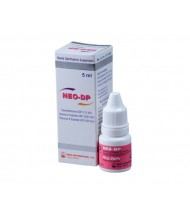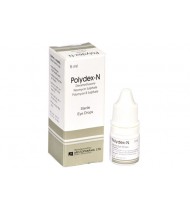Dexamethasone + Neomycin Sulphate + Polymyxin B Sulphate
Indications
This is indicated in ocular inflammation when concurrent use of an antimicrobial is judged necessary.
Pharmacology
Dexamethasone (Corticosteroids) suppress inflammatory response to a variety of agents and they probably delay or slow healing. Since corticosteroid may inhibit the body's defense mechanism against infection, a concomitant antimicrobial drug may be used when this inhibition is considered to be clinically significant in a particular case. The anti-infective component in the combination is included to provide action against specific organisms susceptible to it.
Neomycin Sulphate is considered active against the following microorganisms: Staphylococcus aureus, Corynebacterium diphtheriae, Streptococcus Viridans, Escherichia coli,Klebsiella pneumoniae, Proteus vulgaris, Aerobacter aerogenes, and Haemophilus influenzae.
Polymyxin B Sulphate is considered active against the following microorganism: Pseudomonas aeruginosa, Aerobacter aerogenes, Escherichia coli, Klebsiella pneumoniae and Koch-Weeks bacillus.
When a decision to administer both a corticosteroid and an antimicrobial is made, the administration of such drugs in combination has the advantage of greater patient compliance and convenience, with the added assurance that the appropriate dosage of both drugs is administered, plus assured compatibility of ingredients when both types of drugs are in the same formulation and, particularly, that the correct volume of drug is delivered and retained.
Neomycin Sulphate is considered active against the following microorganisms: Staphylococcus aureus, Corynebacterium diphtheriae, Streptococcus Viridans, Escherichia coli,Klebsiella pneumoniae, Proteus vulgaris, Aerobacter aerogenes, and Haemophilus influenzae.
Polymyxin B Sulphate is considered active against the following microorganism: Pseudomonas aeruginosa, Aerobacter aerogenes, Escherichia coli, Klebsiella pneumoniae and Koch-Weeks bacillus.
When a decision to administer both a corticosteroid and an antimicrobial is made, the administration of such drugs in combination has the advantage of greater patient compliance and convenience, with the added assurance that the appropriate dosage of both drugs is administered, plus assured compatibility of ingredients when both types of drugs are in the same formulation and, particularly, that the correct volume of drug is delivered and retained.
Dosage & Administration
Eye drops: One drop topically into the conjunctival sac(s). In severe disease, drops may be used hourly, being tapered to discontinuation as the inflammation subsides. In mild disease, drops may be used up to four to six times daily.
Eye ointment: It should be applied thinly and evenly to the conjunctival sac(s) at night (if eye drops used during the day) or 3-4 times daily (if eye ointment used alone).
Eye ointment: It should be applied thinly and evenly to the conjunctival sac(s) at night (if eye drops used during the day) or 3-4 times daily (if eye ointment used alone).
Interaction
There are no known drug interactions and none well documented.
Contraindications
Epithelial herpes simplex keratitis (dentritic keratitis), vaccinia, varicella, and many other viral diseases of the cornea and conjunctiva. Hypersensitivity to a component of the medication (Hypersensitivity to the antibiotic component occurs at a higher rate than other component). The use of these combinations is always contraindicated after uncomplicated removal of a corneal foreign body.
Side Effects
Adverse reactions have occurred with steroid/anti-infective combination drugs which can be attributed to the steroid component, the anti-infective component, or the combination. Exact incidence figures are not available since no denominator of treated patients is available. Reactions occurring most often from the presence of the anti-infective ingredient are allergic sensitizations. The reactions due to the steroid component in decreasing order of frequency are: elevation of intraocular pressure (IOP) with possible development of glaucoma, and infrequent optic nerve damage, posterior sub-capsular cataract formation and delayed wound healing.
Pregnancy & Lactation
Pregnancy Category C. Animal reproduction studies have shown an adverse effect on the fetus and there are no adequate and well-controlled studies in humans, but potential benefits may warrant use of the drug in pregnant women despite potential risks
Lactation: Unknown if excreted in breast milk; minimal systemic absorption with ophthalmic administration
Lactation: Unknown if excreted in breast milk; minimal systemic absorption with ophthalmic administration
Precautions & Warnings
Prolonged use may cause glaucoma, damage to the optic nerve, defects in visual acuity and fields of vision, posterior subcapsular cataract formation and increased risk of secondary ocular infections. Increased risk of perforations in diseases which can cause thinning of the cornea or sclera. Corticosteroids may mask infection or worsen existing infections in acute purulent conditions of the eye. Regular monitoring of the intraocular pressure is recommended if product is used for 10 days. Long term application of topical corticosteroids may also increase the risk of ocular fungal infections. Neomycin sulfate may cause cutaneous sensitisation. Pregnancy and lactation.
Therapeutic Class
Ophthalmic steroid - antibiotic combined preparations
Neo-DP Ophthalmic Solution 5 ml drop
IndicationsThis is indicated in ocular inflammation when concurrent use of an antimicrobial is judge..
90.30Tk.
Polydex-N Ophthalmic Solution 5 ml drop
IndicationsThis is indicated in ocular inflammation when concurrent use of an antimicrobial is judge..
90.00Tk.
Showing 1 to 2 of 2 (1 Pages)


